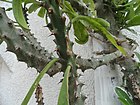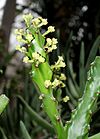Note: This is a project under development. The articles on this wiki are just being initiated and broadly incomplete. You can Help creating new pages.
Difference between revisions of "Euphorbia antiquorum"
| (7 intermediate revisions by the same user not shown) | |||
| Line 2: | Line 2: | ||
'''Euphorbia antiquorum''' tree is a spiny, succulent shrub or small tree growing up to 6 - 9 metres tall. The plant is harvested from the wild and from cultivated plants for local medicinal use. The plant is also cultivated, especially in tropical Asia, where it is planted as an ornamental and barrier hedge. It is also grown as an indoor plant in temperate areas. | '''Euphorbia antiquorum''' tree is a spiny, succulent shrub or small tree growing up to 6 - 9 metres tall. The plant is harvested from the wild and from cultivated plants for local medicinal use. The plant is also cultivated, especially in tropical Asia, where it is planted as an ornamental and barrier hedge. It is also grown as an indoor plant in temperate areas. | ||
==Uses== | ==Uses== | ||
| − | {{Uses|}}, {{Uses|}}, {{Uses| | + | {{Uses|Indigestion}}, {{Uses|Corn}}, {{Uses|Warts}}.<ref name="Uses"/> |
==Parts Used== | ==Parts Used== | ||
| − | {{Parts Used|Young shoots}} | + | {{Parts Used|Young shoots}}, {{Parts Used|Stem}}, {{Parts Used|Plant's milk}}<ref name="Karnataka Medicinal Plants"/> |
==Chemical Composition== | ==Chemical Composition== | ||
| Line 11: | Line 11: | ||
==Common names== | ==Common names== | ||
| − | {{Common names|sa=Snuhu|en=Triangular Spurge|gu=|hi=Tridhara|kn= | + | {{Common names|sa=Snuhu|en=Triangular Spurge|gu=|hi=Tridhara|kn=Kaadu kalli|ks=|ml=Chadurakalli|mr=Narasya|pa=|ta=Chaturakalli|te=Bommajemudu}} |
==Properties== | ==Properties== | ||
| Line 36: | Line 36: | ||
===Flower=== | ===Flower=== | ||
| − | {{Flower||||}} | + | {{Flower|||||Flowering season is November to January}} |
===Fruit=== | ===Fruit=== | ||
| − | {{Fruit||||||}} | + | {{Fruit||||||Fruiting season is November to January}} |
===Other features=== | ===Other features=== | ||
| Line 72: | Line 72: | ||
<ref name="How to plant/cultivate">[Cultivation]</ref> | <ref name="How to plant/cultivate">[Cultivation]</ref> | ||
| − | <ref name="Uses"> | + | <ref name="Uses">Karnataka Medicinal Plants Volume - 2 by Dr.M. R. Gurudeva, Page No. 598</ref> |
| + | <ref name="Karnataka Medicinal Plants">"Karnataka Medicinal Plants Volume - 2" by Dr.M. R. Gurudeva, Page No.598, Published by Divyachandra Prakashana, #45, Paapannana Tota, 1st Main road, Basaveshwara Nagara, Bengaluru. </ref> | ||
| + | |||
</references> | </references> | ||
Latest revision as of 17:06, 23 June 2023
Euphorbia antiquorum tree is a spiny, succulent shrub or small tree growing up to 6 - 9 metres tall. The plant is harvested from the wild and from cultivated plants for local medicinal use. The plant is also cultivated, especially in tropical Asia, where it is planted as an ornamental and barrier hedge. It is also grown as an indoor plant in temperate areas.
Contents
- 1 Uses
- 2 Parts Used
- 3 Chemical Composition
- 4 Common names
- 5 Properties
- 6 Habit
- 7 Identification
- 8 List of Ayurvedic medicine in which the herb is used
- 9 Where to get the saplings
- 10 Mode of Propagation
- 11 How to plant/cultivate
- 12 Commonly seen growing in areas
- 13 Photo Gallery
- 14 References
- 15 External Links
Uses
Parts Used
Young shoots, Stem, Plant's milk[2]
Chemical Composition
Common names
| Language | Common name |
|---|---|
| Kannada | Kaadu kalli |
| Hindi | Tridhara |
| Malayalam | Chadurakalli |
| Tamil | Chaturakalli |
| Telugu | Bommajemudu |
| Marathi | Narasya |
| Gujarathi | |
| Punjabi | |
| Kashmiri | |
| Sanskrit | Snuhu |
| English | Triangular Spurge |
Properties
Reference: Dravya - Substance, Rasa - Taste, Guna - Qualities, Veerya - Potency, Vipaka - Post-digesion effect, Karma - Pharmacological activity, Prabhava - Therepeutics.
Dravya
Rasa
Guna
Veerya
Vipaka
Karma
Prabhava
Habit
Identification
Leaf
| Kind | Shape | Feature |
|---|---|---|
Flower
| Type | Size | Color and composition | Stamen | More information |
|---|---|---|---|---|
| Flowering season is November to January |
Fruit
| Type | Size | Mass | Appearance | Seeds | More information |
|---|---|---|---|---|---|
| Fruiting season is November to January |
Other features
List of Ayurvedic medicine in which the herb is used
Where to get the saplings
Mode of Propagation
How to plant/cultivate
Commonly seen growing in areas
Dry forest, Open forest, Evergreen forest, Scrubby vegetation, Rocky limestone hills.
Photo Gallery
References
- ↑ Karnataka Medicinal Plants Volume - 2 by Dr.M. R. Gurudeva, Page No. 598
- ↑ "Karnataka Medicinal Plants Volume - 2" by Dr.M. R. Gurudeva, Page No.598, Published by Divyachandra Prakashana, #45, Paapannana Tota, 1st Main road, Basaveshwara Nagara, Bengaluru.
- ↑ [Chemistry]
- ↑ [Morphology]
- ↑ [Cultivation]
External Links
- Ayurvedic Herbs known to be helpful to treat Indigestion
- Ayurvedic Herbs known to be helpful to treat Corn
- Ayurvedic Herbs known to be helpful to treat Warts
- Herbs with Young shoots used in medicine
- Herbs with Stem used in medicine
- Herbs with Plant's milk used in medicine
- Herbs with common name in Kannada
- Herbs with common name in Hindi
- Herbs with common name in Malayalam
- Herbs with common name in Tamil
- Herbs with common name in Telugu
- Herbs with common name in Marathi
- Herbs with common name in Sanskrit
- Herbs with common name in English
- Habit - Shrub
- Index of Plants which can be propagated by Seeds
- Index of Plants which can be propagated by Root cuttings
- Herbs that are commonly seen in the region of Dry forest
- Herbs that are commonly seen in the region of Open forest
- Herbs that are commonly seen in the region of Evergreen forest
- Herbs that are commonly seen in the region of Scrubby vegetation
- Herbs that are commonly seen in the region of Rocky limestone hills
- Herbs
- Pages without herbs images




